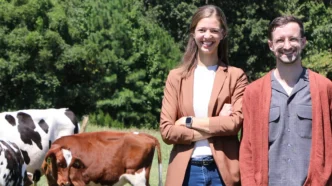Hoofprint Biome is changing the way farmers tackle cow methane emissions while making livestock healthier and more productive. For years, scientists focused on reducing methane to fight climate change but made little real-world progress. Kathryn Polkoff, co-founder and CEO of Hoofprint Biome, saw the problem from a farmer’s point of view—and that made all the difference.
Instead of only thinking about climate impact, Polkoff thought about cow health and efficiency. Her background in animal science helped her and co-founder Scott Collins develop a smarter approach. They discovered a way to fine-tune a cow’s microbiome using natural enzymes. This breakthrough not only cuts harmful methane burps but also improves the nutrients cows can absorb.
Now, Hoofprint Biome has raised a $15 million Series A round led by SOSV, alongside investors like AgriZeroNZ, Alexandria Venture Investments, Amazon’s Climate Pledge Fund, Breakthrough Energy Fellows, Good Growth Capital, Ponderosa Ventures, and Twynam. The funding will help bring their enzyme solution directly to farms for large-scale trials.
A Natural Enzyme Boost for Cows and the Planet
At the heart of Hoofprint Biome’s innovation is a simple idea: treat the cow’s microbiome like an engine. For centuries, farmers have bred cattle for better yields without really improving the internal systems that power them. Polkoff compared it to upgrading a car’s exterior without ever tuning the engine.
The cow’s rumen, a key part of its digestive system, is filled with microbes that break down tough forage. However, some of these microbes steal nutrients and create methane as a byproduct. Hoofprint Biome’s enzymes target and suppress just the small group of microbes responsible for methane, allowing cows to get more nutrition from the same amount of feed.
Using yeast fermentation, Hoofprint Biome produces enzymes similar to those used in making cheese and detergent. Because these enzymes are natural proteins found in the rumen itself, they integrate smoothly without disrupting the cow’s digestion.
Po Bronson, general partner at SOSV, noted that this natural fit will help Hoofprint avoid the backlash faced by earlier methane-reduction products. Since the enzymes degrade like any normal protein, farmers can trust them to be safe and effective.
Turning Methane Reduction into Farm Profitability
Hoofprint Biome is aiming for a 5% boost in feed efficiency, meaning cows can gain more weight with the same amount of food. For farmers, that translates to better profits without extra feeding costs.
Bronson emphasized that simply cutting methane is not enough to win over farmers. By making cows more productive and efficient, Hoofprint Biome offers a clear financial benefit in addition to an environmental one.
By attacking methane emissions from a health and productivity angle, Hoofprint Biome is poised to succeed where others have struggled. It’s not just about saving the planet—it’s about building a more sustainable, profitable future for farming.













